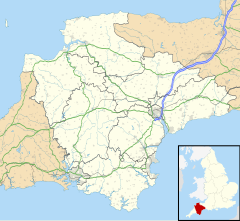Sampford Courtenay: Difference between revisions
Content Tags: Reverted Mobile edit Mobile web edit |
WikiEditor50 (talk | contribs) Lowercase "century" |
||
| (3 intermediate revisions by 3 users not shown) | |||
| Line 1: | Line 1: | ||
{{Short description|Village in Devon, England}} |
|||
{{Use dmy dates|date=October 2019}} |
{{Use dmy dates|date=October 2019}} |
||
{{Infobox UK place |
{{Infobox UK place |
||
| Line 22: | Line 23: | ||
}} |
}} |
||
'''Sampford Courtenay''' is a village and [[civil parishes in England|civil parish]] in [[West Devon]] in [[England]], |
'''Sampford Courtenay''' is a village and [[civil parishes in England|civil parish]] in [[West Devon]] in [[England]], most famous for being the place where the [[Western Rebellion]], otherwise known as the Prayerbook rebellion, first started, and where the rebels made their final stand. It has a population of around 600.<ref>{{Cite web|url=http://www.sampfordcourtenay-pc.gov.uk/|title=Sampford Courtenay website|website=www.sampfordcourtenay-pc.gov.uk|access-date=2019-01-05}}</ref> |
||
most famous for being the place where the [[Western Rebellion]], otherwise known as the Prayerbook rebellion, first started, and where the rebels made their final stand. It has a population of around 600.<ref>{{Cite web|url=http://www.sampfordcourtenay-pc.gov.uk/|title=Sampford Courtenay website|website=www.sampfordcourtenay-pc.gov.uk|access-date=2019-01-05}}</ref> |
|||
The Church of St Andrew is mainly built of granite and has an elegant tower.<ref>Betjeman, J. (ed.) (1968) Collins Pocket Guide to English Parish Churches: the South. London: Collins; p. 165</ref> |
The Church of St Andrew is mainly built of granite and has an elegant tower.<ref>Betjeman, J. (ed.) (1968) Collins Pocket Guide to English Parish Churches: the South. London: Collins; p. 165</ref> |
||
Between 1867 and 1972, the village was served by the nearby [[Sampford Courtenay railway station]] at [[Belstone Corner]]. The station reopened for the heritage [[Dartmoor Railway]] between 2002 and 2021, after which it closed permanently. [[Network Rail]] reclaimed ownership of the [[Dartmoor line]] between {{rws|Yeoford}} and {{rws|Okehampton}} in 2021, but have no plans to reopen the station. |
|||
==Literature== |
==Literature== |
||
Sampford Courtenay is the area author [[M.R. James]] had in mind for his short ghost story [[Martin's Close]] published in [[More Ghost Stories]] in 1911. The New Inn featured in this story is also a real place and a grade II listed old coaching inn originally built in the 16th |
Sampford Courtenay is the area author [[M.R. James]] had in mind for his short ghost story [[Martin's Close]] published in [[More Ghost Stories]] in 1911. The New Inn featured in this story is also a real place and a grade II listed old coaching inn originally built in the 16th century. |
||
==References== |
==References== |
||
Latest revision as of 20:40, 9 March 2023
| Sampford Courtenay | |
|---|---|
 Sampford Courtenay | |
Location within Devon | |
| Population | 600 (2019) |
| OS grid reference | SS6301 |
| Civil parish |
|
| District | |
| Shire county | |
| Region | |
| Country | England |
| Sovereign state | United Kingdom |
| Post town | OKEHAMPTON |
| Postcode district | EX20 |
| Dialling code | 01837 |
| UK Parliament | |
Sampford Courtenay is a village and civil parish in West Devon in England, most famous for being the place where the Western Rebellion, otherwise known as the Prayerbook rebellion, first started, and where the rebels made their final stand. It has a population of around 600.[1]
The Church of St Andrew is mainly built of granite and has an elegant tower.[2]
Between 1867 and 1972, the village was served by the nearby Sampford Courtenay railway station at Belstone Corner. The station reopened for the heritage Dartmoor Railway between 2002 and 2021, after which it closed permanently. Network Rail reclaimed ownership of the Dartmoor line between Yeoford and Okehampton in 2021, but have no plans to reopen the station.
Literature
[edit]Sampford Courtenay is the area author M.R. James had in mind for his short ghost story Martin's Close published in More Ghost Stories in 1911. The New Inn featured in this story is also a real place and a grade II listed old coaching inn originally built in the 16th century.
References
[edit]- ^ "Sampford Courtenay website". www.sampfordcourtenay-pc.gov.uk. Retrieved 5 January 2019.
- ^ Betjeman, J. (ed.) (1968) Collins Pocket Guide to English Parish Churches: the South. London: Collins; p. 165
External links
[edit]![]() Media related to Sampford Courtenay at Wikimedia Commons
Media related to Sampford Courtenay at Wikimedia Commons

